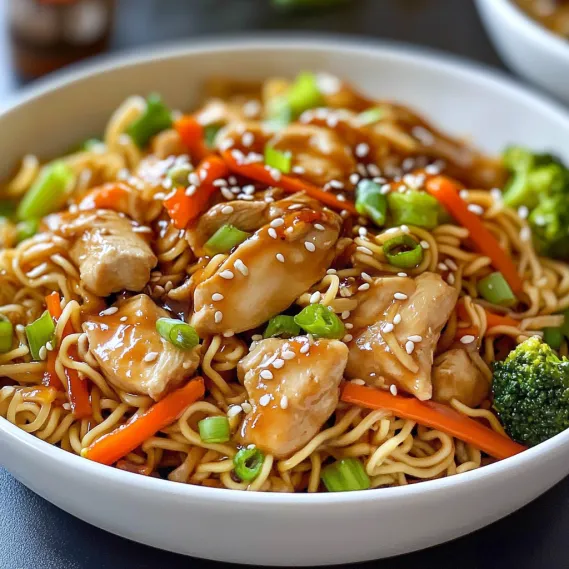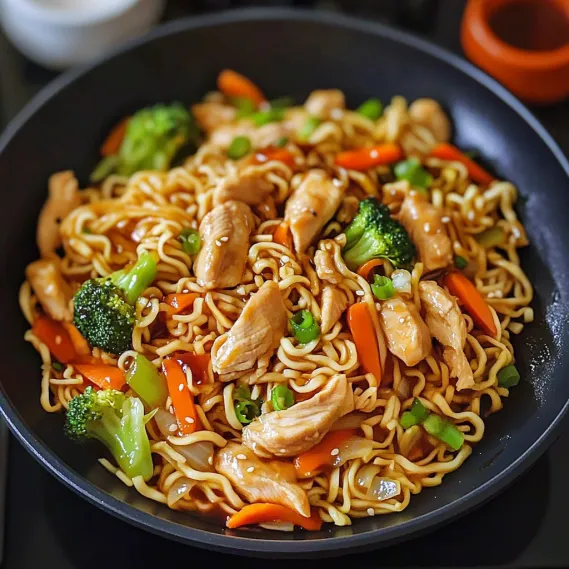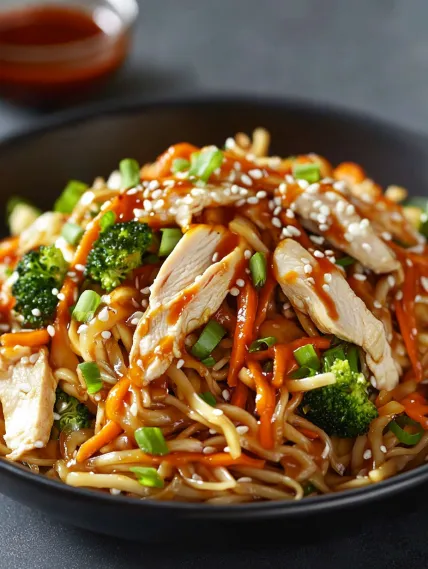 Pin it
Pin it
This filling Chicken Yakisoba turns basic items into a fancy-looking dinner in just over half an hour. When juicy chicken meets crunchy veggies and soft noodles coated in that sweet-sour sauce, you'll get a perfectly balanced mix of tastes and textures.
I whipped up this yakisoba one hectic evening when we needed something quick but still tasty. It was such a hit that we now make it instead of ordering in. The way everything comes together really brings that Japanese street food feel right to your table.
Ingredients
- Cabbage: Gives that needed snap and light sweetness that soaks up all the good sauce. Go for solid heads with fresh, crispy leaves.
- Yellow onion: Adds sweet flavor when cooked down. Pick medium ones with tight outer skin.
- Carrots: Bring natural sweetness and pretty color. Go for firm, bright orange ones for best taste.
- Broccoli: Packs in nutrients and nice texture. Look for bright green, compact florets.
- Fresh ginger: Brings that zingy warmth. Get plump pieces with smooth skin.
- Chicken breast: Gives you that good protein. Try to grab hormone-free if you can.
- Ramen noodles: Create that real yakisoba feel. Just toss the flavor packets and use only the noodles.
- Soy sauce: Makes the salty, savory base. You can grab low-sodium if you want.
- Worcestershire sauce: Adds deep tangy flavor. The real Japanese kind has tamarind and fishy notes.
- Ketchup: Gives tomato sweetness and thickens things up. Try to use one without corn syrup if possible.
- Sriracha: Brings the heat you can control. Add more or less based on what your family likes.
- Sugar: Balances out salty and tangy flavors. You can swap in brown sugar for a deeper taste.
How To Make Tasty Homemade Chicken Yakisoba
- Get Everything Ready:
- Put all your stuff out before you start cooking. This way you won't burn anything while you're still chopping other things. Try to cut all veggies about the same size so they cook evenly. Cut chicken across the grain so it stays tender.
- Flavor The Oil:
- Make sure your pan is hot enough before adding oil - it should look shiny but not be smoking. Drop in ginger right away and keep stirring so it doesn't burn. This step puts all that good flavor into the oil that'll make everything taste better.
- Fix The Chicken:
- Put chicken in without crowding the pan. Let it brown a bit before you move it around. Cook it all the way through but don't overdo it or it'll get tough. Look for chicken that's no longer pink with some nice golden spots.
- Cook The Veggies:
- Throw all veggies in together and stir often. You want them cooked but still a bit crunchy, not mushy. The cabbage will let out some water that helps everything cook without sticking.
- Handle The Noodles:
- Get water boiling while your veggies cook. Watch those noodles carefully since they cook super fast and can turn to mush. Drain them right away and mix with a bit of sesame oil to add flavor and stop them from sticking together.
- Mix The Sauce:
- Stir all sauce stuff in a bowl until sugar melts completely. Give it a taste and adjust if needed. Your sauce should have a good mix of sweet, salty, tangy and spicy.
- Put It All Together:
- Pour sauce evenly over everything in the pan. Add noodles gently so they don't break. Let it all bubble together briefly so flavors mix and sauce gets a bit thicker. Your dish should be wet with sauce but not swimming in it.
 Pin it
Pin it
What makes yakisoba really pop is getting that sauce just right. I figured out this perfect mix after trying tons of different versions. My grandma always told me good cooking means finding the right balance between different flavors. This sauce nails that idea by bringing together sweet, salty, tangy and spicy in just the right amounts.
Traditional Japanese Twists
Real Japanese yakisoba often uses things like oyster sauce, bonito flakes, and aonori seaweed powder. While this recipe uses stuff you can find at regular American stores, it still captures the true spirit. In Japan, people grab yakisoba at street festivals where it's topped with pickled ginger and mayo. The vendors cook it on big flat grills called teppan that give it a slight char that makes it taste even better.
Storage And Reheating
Keep any extras in sealed containers in the fridge for up to 4 days. It actually tastes better the next day as the sauce soaks into everything overnight. When you warm it up, add a tiny bit of water to keep it from drying out and heat it slowly in a covered pan on medium. Don't use the microwave or your noodles might get rubbery. If you're prepping meals ahead, try keeping everything separate until you're ready to heat it up for the best texture.
 Pin it
Pin it
Ingredient Swaps
The great thing about yakisoba is how flexible it is. You can use thin-sliced beef, pork, tofu, or shrimp instead of chicken if you want. For a veggie version, just use more vegetables and throw in some mushrooms for that savory flavor. You can also change up the veggies based on what you have. Bell peppers, snow peas, bean sprouts, and spinach all work great. If you can't have gluten, try rice noodles and tamari instead of regular soy sauce. You can also change the sauce by using honey instead of sugar or coconut aminos instead of soy sauce.
Frequently Asked Questions
- → Is there an alternative noodle I can use?
Sure, swap ramen for udon, soba, or even spaghetti. Just adjust cooking times to suit your noodle choice.
- → What veggies work well in this?
Try adding or swapping in bell peppers, zucchini, mushrooms, or snap peas for some variety.
- → Can I switch this to a meat-free version?
Of course! Replace the chicken with tofu, tempeh, or load it up with extra veggies. Use veggie-friendly Worcestershire too.
- → How do I keep the noodles from clumping?
After cooking and draining, toss your noodles with some sesame or vegetable oil to keep them loose.
- → What can I do if I want less spice?
Skip or use less sriracha for a milder option. Add a touch more sugar if you like it sweeter.
- → Can I prepare parts of this ahead of time?
Yes! Prep your veggies, sauce, and noodles in advance. Mix everything together right before serving for the best taste and texture.
- → What other proteins could I try?
Switch it up by using shrimp, beef, or scrambled eggs as tasty substitutes for chicken.
